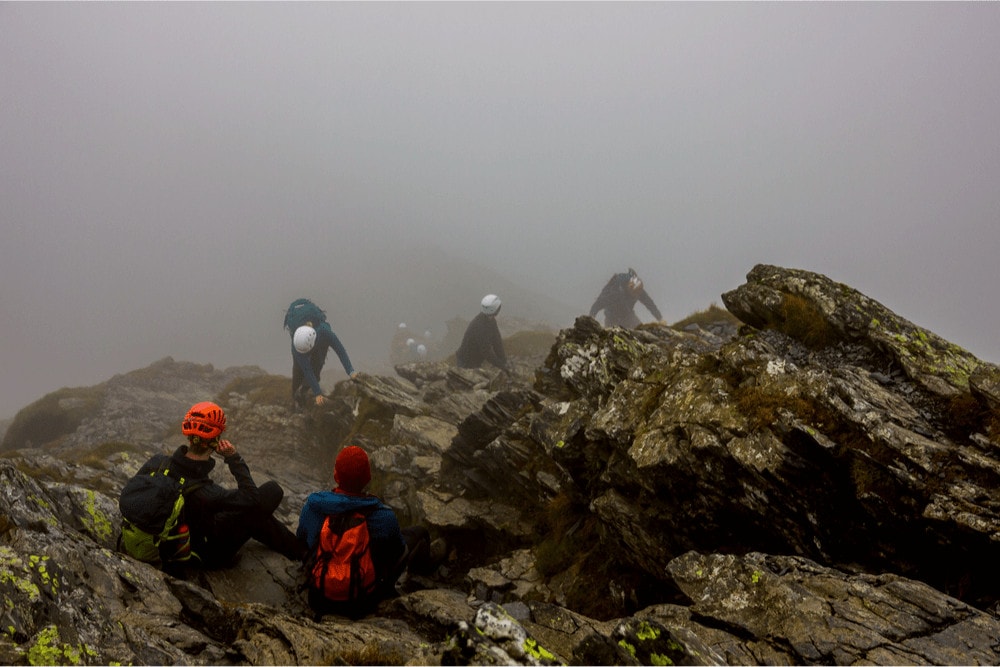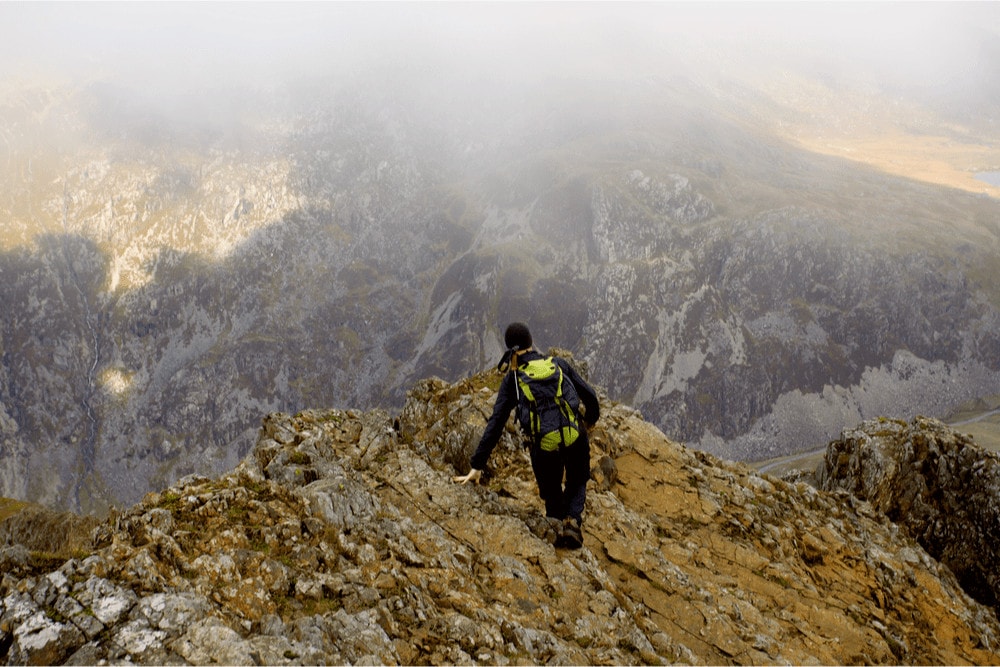Outforia Quicktake: Key Takeaways
- Scrambling is a form of hiking that requires the use of both hands and feet, falling somewhere between hiking and rock climbing.
- It often takes place on informal or nonexistent trails, adding to the difficulty and requiring mental clarity for pathfinding.
- There are three degrees of difficulty in scrambling: Grade 1 (beginner), Grade 2 (intermediate), and Grade 3 (advanced).
- Proper preparation, such as understanding risks, bringing the right gear, and planning in advance, is essential for successful scrambling.
- Scrambling is distinct from rock climbing, as it typically does not involve ropes or supportive gear.
The activity known as scrambling falls somewhere between regular hiking and rock climbing. And if you have spent enough time summiting mountains, you may have come across this term before. But what is scrambling in hiking, and how does it differ from other related activities? Read on to learn the answers to those questions and more.
The Basics of Scrambling

In the simplest sense, scrambling is a form of hiking that requires the use of both hands and feet. This activity often takes place in the mountains and can be extremely strenuous.
Scrambling stands alone as a distinct activity. However, it shares an extremely close relationship with both hiking and climbing. For that reason, we’ll describe scrambling by comparing it to those activities with which it is most similar.
Between Hiking and Climbing
There are many ways that scrambling is both alike and unlike hiking and rock climbing. From a broad perspective, all of these activities take place mainly outdoors and involve ascending some sort of slope.
For instance, both hiking and scrambling involve navigating to the top of a hill or mountain. Likewise, both of these activities typically take place without the aid of harnesses or special safety equipment.

Unlike when hiking, you will use both your hands and your feet while you scramble. That is because scrambling often takes place on slopes that are steeper than those you would hike. However, there are some instances in which you might combine hiking and scrambling to summit a peak.
Mountain scrambling also shares some commonalities with rock climbing. The main similarity here is that both of these activities require that you use all four of your limbs. Both scrambling and climbing also involve gaining strategic hand and footholds on rocky terrain.
The primary difference between scrambling and climbing is that scrambling does not usually involve ropes or supportive gear. That is because scramblers take on slopes that are more manageable, while rock climbers might scale cliffs that are vertical.
Due to these similarities, it is safe to say that scrambling falls somewhere in between hiking and rock climbing. With that distinction in place, let’s proceed to learn more about scrambling.
Informal Trails

There is another important difference between hiking and scrambling that we have yet to mention. Unlike hiking, scrambling often takes place in areas where the trails are either very informal or nonexistent.
This lack of trail markings forces a scrambler to define their own path up the incline. This adds to the difficulty of scrambling by engaging both the mind and the body. While you may begin to feel physically exhausted, you must maintain enough mental clarity to discern your path to the top.
The nature of scrambling trails adds a degree of danger to this activity. If you lose focus, you may find yourself off course.
Because of this risk, one of the main skills that a scrambler develops is the ability to find their way to the top of an incline. To achieve this, they often seek the most direct route, even if that route is relatively steep.
Degrees of Difficulty

It may seem that scrambling is an entirely informal activity, that is not the case. In fact, there is an agreed-upon ranking system that works to describe the difficulty of certain forms of scrambling. Those degrees of difficulty exist within three tiers.
Grade 1 Scrambling
Grade 1 is the entry-level for scrambling. These routes tend to be fairly easy to navigate, making them ideal for beginners.
A grade 1 scramble is the least steep of all the grades, and at times, you might feel like you are hiking. Still, there will be plenty of inclines that will call for the use of your hands.
Grade 2 Scrambling
Grade 2 will intensify your scrambling experience. Compared to grade 1, the grade 2 slopes are steeper and are therefore one of the harder scrambles.
This scrambling difficulty level often includes longer scrambles as well. At times, the steepness of the incline might mean you need to use a rope for safety. But this is not usually the case.
Grade 3 Scrambling
Grade 3 is the hardest scrambling level. This grade requires skill and experience before it is safe for you to attempt it.
Don’t try to take on a grade 3 scramble until you have practiced many times on grade 1 and 2 scrambles. To prepare yourself, it may also be helpful to practice some rock climbing. This will help you scale the intense slopes that exist at grade 3.
You may also like: Walking With Nature: A Guide To 20 Different Types Of Hiking
A Few Tips for Successful Scrambling
Now that you know what scrambling is, you are ready to learn a bit more about how to do it successfully. Since scrambling can be a dangerous activity, it is important to have the proper preparation. The next few sections will help you with that preparation process.
1. Understand the Risk

The most important aspect of preparing to scramble for the first time is understanding the risk that is always present with this activity. While hiking itself can be dangerous, scrambling takes that danger to a new level.
When scrambling, you will often come across terrain that is extremely difficult to manage. Simultaneously, you may need to maneuver near drop-offs or cliff edges.
For those reasons, it is vital that you remain alert and in control while you scramble. Always work at your own comfortable pace to ensure you don’t make a mistake. Failing to do so could result in a fall. Depending on how and where you fall, you may end up with a severe injury.
Scrambling may not be as treacherous as rock climbing. But it does represent a significant step up in difficulty from hiking. That is why you should take as many precautions as you need before you embark on your first scrambling adventure.
2. Bring the Right Gear
Before you scramble, you need to make sure you are well-equipped for the task. The most important piece of gear you will need is a pair of hiking shoes.
The shoes you select should be durable enough to withstand a tough trail. But they must also allow for enough movement so that you can scramble without any restrictions.

When selecting footwear for scrambling, you should pay special attention to the toe portion of the shoes you are considering. Always select a shoe or boot that has a strong toe bumper. This toe bumper will prevent you from getting injured in the case that you happen to stub your toe.
Beyond footwear, you will need to make several other gear selections. Some of these considerations are a lot like those you would make for a standard hiking outing.
For example, you’ll need to wear clothes that are both comfortable and weather-appropriate, such as a long-sleeved shirt that protects against UV rays. Since scrambling can take place over several hours, proper weather preparation is a must.
Some people choose to wear gloves as they scramble as well. This is a great way to keep your hands from getting calloused or cut on the rocks. Since you will be using your hands a lot while scrambling, it makes sense that they might need some additional protection.
You might want to consider bringing a water supply as well. This will ward off the dangers of dehydration as you scramble. But again, you should try to find a means of carrying water that won’t weigh you down or restrict your movement.
3. Plan in Advance
Advanced planning is the most important aspect of scrambling, so having guidebooks for rock climbing may be the best place to start. A preemptive mindset is what can resolve a lot of issues before they even arise. However, you might be surprised to find that this planning should take place at all stages of the process.
As you would expect, it is important to create a detailed plan in the weeks leading up to your scramble. Not only should you be familiar with the slope you intend to take on. You also need to plan your exact route beforehand as well.

Remember that planning your descent is just as important as planning your ascent. Most people pay attention to how they will get to the top of the slope and very little regarding how they will get down.
What you should know is that the descent of a scramble is one of the more dangerous parts. During that phase, the steepness of the slope and the force of gravity work together to create a hazardous situation.
One of the best ways to avoid that is to find an alternative walking route down to avoid loose rocks. This will eliminate a lot of the risk of falling on the descent.
Those plans all relate to your general approach to scrambling, but you will need to continue your careful planning during the scramble as well.
Since scrambling takes place on somewhat steep slopes, each move you make is crucial. As such, you need to test each handhold and foothold before you place your weight on it. Placing weight on a loose rock accounts for many scrambling accidents.
This is an example of the short-term planning you will need to use while scrambling. With this mindset, you stand the best chance of circumventing an avoidable injury.
You May Also Like: Check Out These Mountain In Virginia That You Might Want To Hike On with Guide, Facts, Photos, and more!
Frequently Asked Questions
Scrambling is a new concept to most. With that in mind, we decided to address a few of the most commonly asked questions. You can find the answers to those questions below.
What Is Considered a Hard Hike?
Generally, the length, steepness, and quality of terrain are most important. The hikes that are long and steep over uneven ground are considered the hardest pursuits of rock climbing and hiking.
What Do You Wear to Scramble?
When you scramble, you should wear comfortable hiking clothing and protective footwear. Some scramblers also like to use gloves to protect their hands as well as ropes in case they need to scale a dangerous incline.
What Is Rock Scrambling?
Rock scrambling is an activity that involves using your hands and feet to scale a section of rocks or boulders. This activity is similar to hiking but often takes place on steeper routes. However, rock scrambling is not the same as rock climbing.







